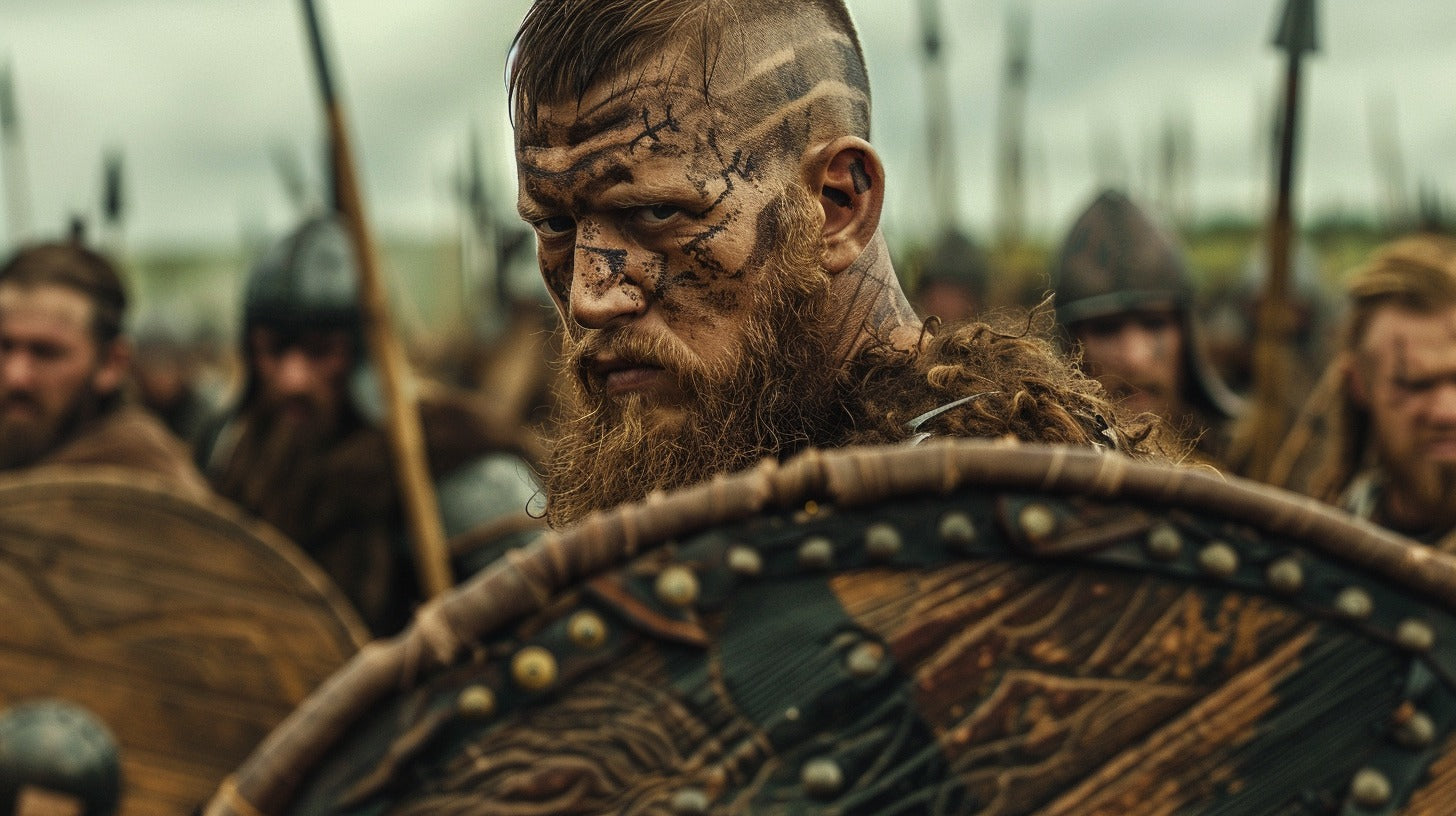
Ivar the Boneless: The Fearsome Viking Ruler
In the annals of Viking history, few figures have captured the imagination quite like Ivar the Boneless. This enigmatic ruler, shrouded in legend and mystery, left an indelible mark on the medieval world with his military prowess and unwavering determination. Join us as we explore the captivating tale of Ivar the Boneless, a man whose name still resonates centuries after his reign.
Early Life and Origins
Ivar's origins are inextricably linked to one of the most legendary figures in Viking lore: Ragnar Lothbrok. According to Norse sagas, Ivar was one of the sons of this fearsome Viking warrior and king, whose own exploits of raiding and conquest laid the groundwork for his children's future endeavors. The sagas tell us that Ivar was born to Ragnar and his wife Aslaug, a woman said to possess prophetic powers.
However, beyond this legendary lineage, the details of Ivar's birth and upbringing remain shrouded in mystery, fueling countless debates and speculations among scholars and enthusiasts alike. Was he raised in the harsh realities of Viking warfare from an early age, learning the arts of strategy and combat at his father's knee? Or are the tales of his parentage merely later embellishments to an already extraordinary life? The scarcity of definitive records has allowed for a rich tapestry of tales to emerge, each weaving its own narrative around this intriguing figure.
What we can surmise is that Ivar's early life, whether spent in royal halls or more humble surroundings, laid the foundation for his future as a formidable warrior and leader. The legacy of Ragnar Lothbrok, be it historical or legendary, undoubtedly cast a long shadow over Ivar's life, shaping his ambitions and perhaps driving him to prove himself a worthy heir to his father's fearsome reputation.
How Did Ivar the boneless Get His Name?
One of the most intriguing aspects of Ivar's life is the origin of his peculiar nickname, "the Boneless." While some historical records suggest he may have suffered from a physical disability or condition that rendered his bones unusually flexible or brittle, there is a theory that his nickname was a mistranslation. According to this theory, Ivar's original Old Norse nickname was "Auðbrandr inn Illi," which has been interpreted to mean "the Cruel" or "the Ill-disposed." However, when this was translated into Latin, it became "Exosus," which eventually led to the English translation of "the Boneless."
If this theory holds true, Ivar's epithet could have initially referred to his formidable and feared reputation as a warrior and ruler, rather than any physical condition. Alternatively, others interpret the "Boneless" moniker as a metaphor for his cunning intellect and adaptability on the battlefield. Could this seemingly contradictory epithet be a nod to his ability to bend and adapt like a reed in the wind, outmaneuvering his foes with strategic brilliance? The true nature and origins of his nickname remain a topic of heated discourse among scholars, adding to the allure of this legendary figure whose very name continues to captivate centuries later.
Ivar's Rise to Power

Ivar's ascent to power was inextricably linked to the exploits of the formidable Great Heathen Army, a massive force of Norse warriors that launched a series of attacks on Anglo-Saxon kingdoms during the 9th century. As one of the purported leaders of this fearsome army, Ivar spearheaded audacious campaigns that struck fear into the hearts of those who stood in their way. From the shores of England to the heart of modern-day France, Ivar and the Great Heathen Army left a trail of destruction and plunder, solidifying his reputation as a formidable warrior and leader.
It was through the overwhelming force of the Great Heathen Army that Ivar truly cemented his legacy. In 866 CE, Ivar led the conquest of York (then known as Eoforwic), one of the most important cities in Anglo-Saxon England. This strategic victory marked a turning point in the Viking invasion. After a prolonged campaign, this massive Viking military force managed to conquer the kingdom of Northumbria, with York, under its Norse name Jórvík, becoming the capital of the Viking kingdom in northern England.
Reign as King
Once installed as the king of Northumbria, with York as his power base, Ivar wasted no time in solidifying his grip on power. He employed a mixture of brutal force and shrewd diplomacy, quelling dissent and forging alliances with neighboring kingdoms. His reign was marked by a period of relative stability, during which he consolidated his control and laid the foundations for the Viking presence in the region. York flourished under Viking rule, becoming a major economic and political center.

A fifteenth-century depiction of Ívarr and Ubba ravaging the countryside from folio 48r of British Library Harley 2278.
Ivar's ability to balance strength and strategy was crucial in maintaining his hold over Northumbria and York, ensuring that his legacy would endure long after his death. It is believed that the Uí Ímair dynasty, which ruled portions of Ireland and Scotland for centuries, descended from Ivar or his close kin, further cementing his lasting impact on the political landscape of the British Isles.
Conflicts and Battles
However, Ivar's reign was far from peaceful. He faced numerous challenges and conflicts, both from within his kingdom and from external forces determined to dislodge him from power. Accounts of his battles against rival kings and armies paint a vivid picture of a ruler who was as fearless on the battlefield as he was cunning in his strategies. Can you imagine the clash of steel and the thunderous roar of battle cries as Ivar's warriors engaged their foes? The sagas recount tales of his daring tactics and unwavering courage, cementing his reputation as a formidable military leader.
Legacy and Influence
Ivar's impact extended far beyond his lifetime. His reign set the stage for the continued Viking influence in the British Isles, paving the way for the eventual establishment of the Danelaw, a region in which Danish law and customs held sway. Even today, his name remains synonymous with Viking might and the era of Norse exploration and conquest. Ivar's legacy serves as a testament to the enduring impact of the Vikings on European history, reminding us of the indelible mark left by these seafaring warriors and rulers. The Uí Ímair dynasty, believed to be descended from Ivar or his close relatives, continued to shape the political landscape of the region for centuries after his death.
Descriptions from Historical Accounts
While no definitive physical descriptions of Ivar exist, historical accounts offer tantalizing glimpses into his appearance. Some chronicles depict him as a formidable warrior, towering over his foes with an imposing presence. Others suggest that he possessed an almost otherworldly aura, commanding respect and fear in equal measure. These fragmented accounts only add to the enigma of Ivar the Boneless, fueling our curiosity and imagination. Was he a giant of a man, striking an intimidating figure on the battlefield? Or did his power emanate from an intangible quality, a charisma that inspired both loyalty and dread?
Military Prowess

One of the hallmarks of Ivar's reign was his mastery of military strategy. He was known for his innovative tactics and ability to outmaneuver his opponents on the battlefield. From feinting attacks to strategic retreats, Ivar's approach to warfare was marked by a level of cunning and adaptability that kept his enemies constantly off-balance. Imagine the surprise and dismay of rival commanders as Ivar's forces executed complex maneuvers, turning the tide of battle in an instant. His genius for strategy was a key factor in his success, allowing him to overcome numerical disadvantages and achieve victory against formidable foes.
Fearsome Reputation
Ivar's reputation as a fearsome warrior and leader preceded him. Tales of his exploits spread like wildfire, instilling fear and respect in the hearts of those who dared to challenge him. His very name was enough to send shivers down the spines of enemy armies, who knew all too well the devastation that Ivar and his forces could unleash. One can imagine the dread that must have gripped the inhabitants of villages and towns as news of Ivar's approach spread, prompting hasty preparations for defense or, in some cases, outright abandonment. Such was the power of his fearsome reputation.
Cultural Impact
Ivar's legacy has transcended the confines of history, finding its way into the realm of literature and folklore. In the Norse sagas and medieval chronicles, he is portrayed as a larger-than-life figure, a symbol of Viking might and audacity. His exploits have inspired countless tales and legends, cementing his place in the collective imagination of generations to come. From the grandmothers who regaled wide-eyed children with stories of his daring raids to the bards who sang of his conquests in great halls, Ivar's name became synonymous with the very essence of Viking culture.
Even in the modern era, Ivar's legacy endures. He has been depicted in various forms of popular culture, from books and films to television series and video games. These portrayals, while often romanticized or fictionalized, serve as a testament to the enduring fascination with this enigmatic figure and the era he helped shape. Whether portrayed as a fearless warrior or a cunning strategist, Ivar's influence transcends time, captivating audiences across cultures and generations.

A depiction of Ívarr and Ubba setting forth to avenge their father, Loðbrók, from folio 47v of British Library Harley 2278.
In the end, Ivar the Boneless remains an enigma, a figure whose life and deeds have been shrouded in mystery and legend. Yet, his impact on history is undeniable, and his name will forever be etched in the annals of Viking lore, a reminder of the fearless spirit and unwavering determination that defined an age of exploration and conquest.
FAQs
- What is the true origin of Ivar's nickname, "the Boneless"?
The exact origin of Ivar's peculiar nickname remains a subject of debate among historians and scholars. While some believe it refers to a physical condition or disability, others interpret it as a metaphorical reference to his cunning and adaptability on the battlefield.
- How did Ivar rise to power and become the King of Northumbria?
Ivar's rise to power was marked by a series of daring Viking raids and conquests, during which he and his brothers struck fear into the hearts of their enemies. Through a combination of military might and strategic alliances, Ivar claimed the throne of Northumbria, establishing a foothold for Viking influence in the British Isles.
- What was Ivar's reputation as a military leader?
Ivar was renowned for his innovative battle strategies and cunning tactics, which allowed him to outmaneuver and defeat formidable foes. His fearsome reputation preceded him, instilling dread in the hearts of enemy armies and striking terror into the populace.
- How has Ivar's legacy endured through literature and popular culture?
Ivar's exploits have been immortalized in Norse sagas, medieval chronicles, and various forms of modern popular culture, including books, films, television series, and video games. His name has become synonymous with the very essence of Viking culture and the era of Norse exploration and conquest.
- What impact did Ivar's reign have on the Viking influence in the British Isles?








